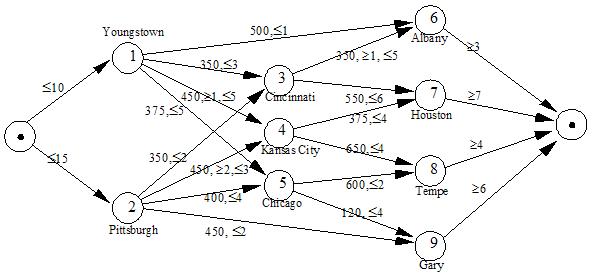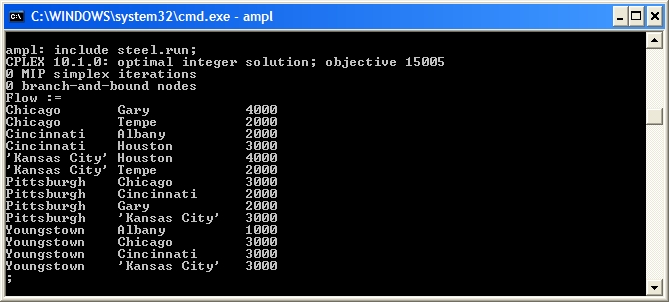|*FORM FIELD ProblemFormulation*|ProblemFormulation|The American Steel Problem can be solved as a transshipment problem. The supply at the supply nodes is the maximum production at the steel mills, i.e., 10,000 and 15,000 for Youngstown and Pittsburgh repsectively. The demand at demand nodes in given by the demand at the field warehouses and the other nodes are transshipment nodes. The costs and bounds on flow through the network are also given. The most compact formulation for this problem is a network formulation (see The Transshipment Problem for details).
 |
|*FORM FIELD ComputationalModel*|ComputationalModel|We can use the AMPL model file
|
|*FORM FIELD ComputationalModel*|ComputationalModel|We can use the AMPL model file transshipment.mod (see The Transshipment Problem in AMPL for details) to solve the American Steel Transshipment Problem. We need a data file to describe the nodes, arcs, costs and bounds. The node set is simply a list of the node names:
set NODES := Youngstown Pittsburgh
Cincinnati 'Kansas City' Chicago
Albany Houston Tempe Gary ;
Note that Kansas City must be enclosed in ' and ' because of the whitespace in the name.
The arc set is 2-dimensional and can be defined in a number of different ways:
# List of arcs
set ARCS := (Youngstown, Albany), (Youngstown, Cincinnati), ... , (Chicago, Gary) ;
# Table of arcs
set ARCS: Cincinnati 'Kansas City' Chicago Albany Houston Tempe Gary :=
Youngstown + + + + - - -
Pittsburgh + + + - - - +
.
.
.
# Array of arcs
set ARCS :=
(Youngstown, *) Cincinnati 'Kansas City' Chicago Albany
(Pittsburgh, *) Cincinnati 'Kansas City' Chicago Gary
.
.
.
(Chicago, *) Tempe Gary
;
Since the node set is small and the arc set is "dense", i.e., many of the node pairs are represented in the arc set, we choose a table to define ARCS:
set ARCS: Cincinnati 'Kansas City' Chicago Albany Houston Tempe Gary :=
Youngstown + + + + - - -
Pittsburgh + + + - - - +
Cincinnati - - - + + - -
'Kansas City' - - - - + + -
Chicago - - - - - + + ;
The NetDemand can be defined easily from the supply and demand. Since the default is 0 we don't need to define NetDemand for the transshipment nodes:
param NetDemand :=
Youngstown -10000
Pittsburgh -15000
Albany 3000
Houston 7000
Tempe 4000
Gary 6000
;
We can use lists, tables or arrays to define the parameters for the American Steel Transhippment Problem,
but in this case we will use a list and define multiple parameters at once. This allows us to "cut-and-paste" the parameters from the problem description. Note the use of
. for parameters where the defaults will suffice (e.g., Lower for Youngstown and Albany):
param: Cost Lower Upper:=
Youngstown Albany 500 . 1000
Youngstown Cincinnati 350 . 3000
Youngstown 'Kansas City' 450 1000 5000
Youngstown Chicago 375 . 5000
Pittsburgh Cincinnati 350 . 2000
Pittsburgh 'Kansas City' 450 2000 3000
Pittsburgh Chicago 400 . 4000
Pittsburgh Gary 450 . 2000
Cincinnati Albany 350 1000 5000
Cincinnati Houston 550 . 6000
'Kansas City' Houston 375 . 4000
'Kansas City' Tempe 650 . 4000
Chicago Tempe 600 . 2000
Chicago Gary 120 . 4000
;
Note that the cost is in $/1000 ton, so we must divide the cost by 1000 in our script file before solving:
reset;
model transshipment.mod;
data steel.dat;
let {(m, n) in ARCS} Cost[m, n] := Cost[m, n] / 1000;
option solver cplex;
solve;
display Flow;
|
|*FORM FIELD Results*|Results|Using transshipment.mod, and the data and script files defined in Computational Model we can solve the American Steel Transshipment Problem to get the optimal Flow variables:
 If the total supply is greater than the total demand, the transshipment problem will solve, but flow may be left in the network (in this case at the Pittsburgh node). In
If the total supply is greater than the total demand, the transshipment problem will solve, but flow may be left in the network (in this case at the Pittsburgh node). In transshipment.mod we check that sum {n in NODES} NetDemand[n] <= 0 to ensure a problem is feasible before solving.
If total supply is less than demand (hence the problem is infeasible) we can add a dummy supply node (see with arcs to all the demand nodes. The optimal solution will show the "best" nodes to send the extra supply to.
| | 
 |
|*FORM FIELD ComputationalModel*|ComputationalModel|We can use the AMPL model file
|
|*FORM FIELD ComputationalModel*|ComputationalModel|We can use the AMPL model file  If the total supply is greater than the total demand, the transshipment problem will solve, but flow may be left in the network (in this case at the Pittsburgh node). In
If the total supply is greater than the total demand, the transshipment problem will solve, but flow may be left in the network (in this case at the Pittsburgh node). In